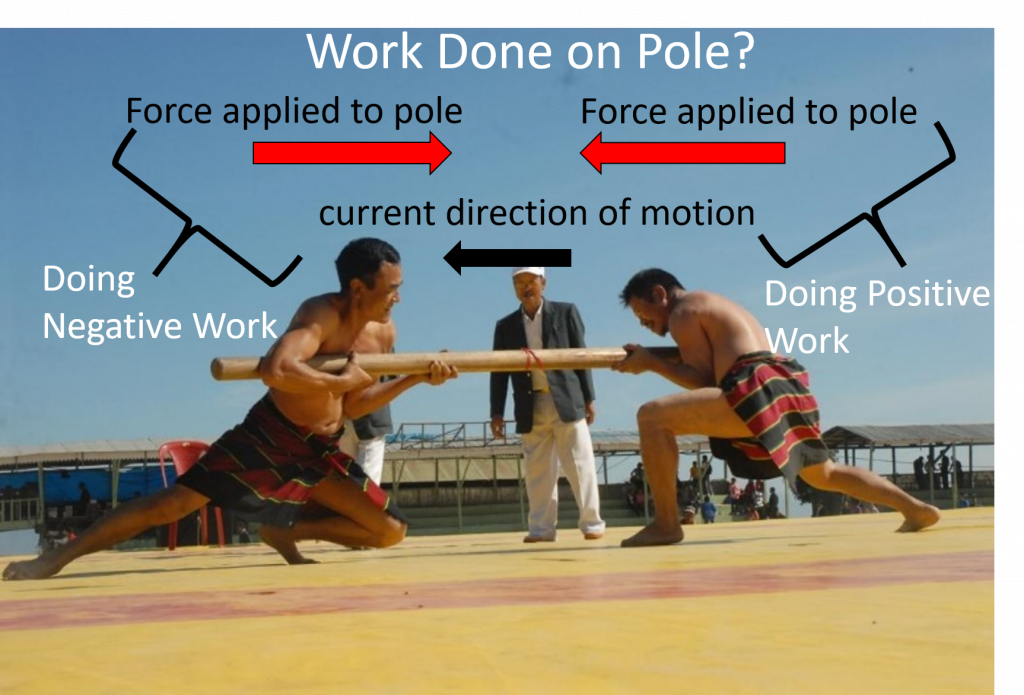66 Doing Work
doing Work
Doing work, such as lifting a patient or moving a gurney, requires applying a force over some distance. The sign of the work done on an object determines if the object’s energy increased or decreased. For example, the athlete on the right is doing positive work on the pole because he is applying a force in the same direction as the pole’s motion. That will tend to speed up the pole and increase the kinetic energy of the pole. The athlete on the left is doing negative work on the pole because the force he applies tends to decrease the kinetic energy of the pole.

Calculating Work
The actual amount of work done is calculated from a combination of the average force, the distance over which it is applied, and the angle between the two:
(1) ![]()
Everyday Example: Moving a gurney
In order to move a rolling gurney to another room Jolene applies a 20 N force to the gurney for a distance of 20 m. How much work did Jolene do?
Jolene applied the force in the same direction as the gurney, so the angle between force and motion was 0°. Entering these values in the work equation we can find the work done on the gurney:
![]()
We see that work has units of Nm, which are called a Joules (J). All forms of energy use these same units as work because energy is an accounting of the capacity to do work. 400 J of work was done on the gurney. That work was done by Jolene, which means that her capacity to do work, or her energy, must have decreased. If the body were 100% efficient then we would know that Jolene’s chemical potential energy decreased by exactly 400 J, the amount of work she did on her environment, but the body is not 100% efficient. Jolene’s chemical potential energy actually decreased by more 400 J. Later in this unit we will learn more about accounting for different energy types and calculating the efficiently of the body.
The ![]() in the work equation automatically tells us whether the work is transferring energy into or out of a particular object:
in the work equation automatically tells us whether the work is transferring energy into or out of a particular object:
- A force applied to an object in the opposite direction to its motion will tend to slow it down, and thus would transfer kinetic energy out of the object. With energy leaving the object, the work done on the object should be negative. The angle between the object’s motion and the force in such a case is 180° and
 , so that checks out.
, so that checks out. - A force applied to an object in the same direction to its motion will tend to cause it to speed up, and thus would transfer kinetic energy in to the object. With energy entering the object, the work done on the object should be positive. The angle between the object’s motion and the force in such a case is 0° and
 so that also checks out.
so that also checks out. - Finally, if a force acts perpendicular to an objects motion it can only change its direction of motion, but won’t cause it to speed up or slow down, so the kinetic energy doesn’t change. That type of force should do zero work. The angle between the object’s motion and the force in such a case is 90° and
 so once again, the
so once again, the  in the work equation gives the required result. For more on this particular type of situation read the chapter on weightlessness at the end of this unit.
in the work equation gives the required result. For more on this particular type of situation read the chapter on weightlessness at the end of this unit.
Reinforcement Exercises
The work equation gives the correct work done by a force, no matter the angle between the direction of force and the direction of motion, even if the force points off at some angle other than 0°, 90°, or 180°. In such a case, some part of the force will be doing work and some part won’t, but the ![]() tells us just how much of the force vector is contributing to work. The
tells us just how much of the force vector is contributing to work. The ![]() accounts for the force direction so we only use the size of the force (F) in the equation and don’t put in negative or positive to indicate the direction the force points.
accounts for the force direction so we only use the size of the force (F) in the equation and don’t put in negative or positive to indicate the direction the force points.
- Adapted from Insuknawr (Rod Pushing Sport by H. Thangchungnunga [CC BY-SA 3.0 (https://creativecommons.org/licenses/by-sa/3.0) or GFDL (http://www.gnu.org/copyleft/fdl.html)], from Wikimedia Commons ↵
- Image and associated practice problem were adapted from "This work" and by BC Open Textbooks is licensed under CC BY 4.0 ↵
any interaction that causes objects with mass to change speed and/or direction of motion, except when balanced by other forces. We experience forces as pushes and pulls.
energy stored in the motion of an object
A quantity representing the effect of applying a force to an object or system while it moves some distance.
A quantity representing the capacity of an object or system to do work.
A quantity representing the effect of applying a force to an object or system while it moves some distance.
at an angle of 90° to a given line, plane, or surface

